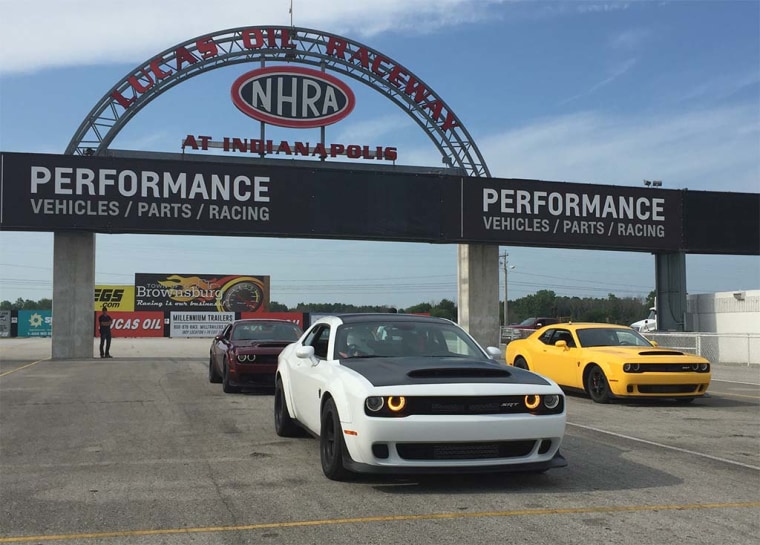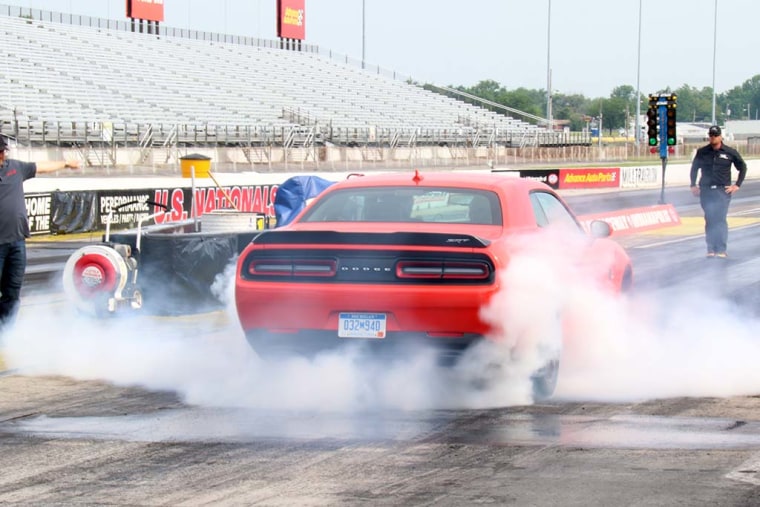At 840 horsepower, the Dodge Challenger SRT Hellcat Demon is so quick you’ll hit 60 before you can say its full name, so, most folks are just calling it the Dodge Demon.
How fast is it? If you have to ask…well, you’ll hit 60 in 2.3 seconds and blow through the quarter-mile traps on a drag strip in less than 9.7 seconds. Or so I am hoping to accomplish as I slip behind the wheel of this cherry red beast at the Lucas Oil Speedway in Indianapolis, Indiana.

Mastering the monstrous, supercharged 6.2-liter V-8 under the hood is no easy matter for a beginner; not if you want to feel the full 1.3 Gs of acceleration thrust you back into its enveloping sport seat. But I’m determined not to make a fool of myself as I pull up to the water box and tap on the Demon’s touchscreen display, flipping the car into Drag Strip mode.
Immediately, the cabin warms up by at least 10 degrees. In an impressive engineering feat, Dodge engineers have found a way to divert the Demon’s climate control system to cool air going into the engine. Cooler air means more power. And on the dragstrip, every pony counts.
My co-pilot signals for me to slip into Line Lock mode, locking up the front wheels while letting the back tires spin maniacally. That creates more than a cloud of smoke. Warm tires are sticky tires, and that’s the best way to get all that power to the pavement.
Pulling up to the “Christmas tree,” I switch this time to Launch Control, and watch as the lights countdown…blink,blink,blink…green. But instead of a screech, the tires let out a groan and the instrument cluster tells me, in less than ambiguous terms, I have, indeed, made a fool of myself.
A successful launch is a complex affair, it seems, requiring almost superhuman dexterity and speed. So, we set up one more time. Blink, blink, blink. And this time it all comes together. I release the left shift paddle and brake simultaneously, my right foot slamming the gas pedal to the floor.
My vision narrows as the blood flows to the back of my brain. “You got air that time,” my co-pilot says, and indeed, the nose of the Demon has lifted more than a foot off the ground as we blast down the dragstrip, pass the traps and slam on the brakes. I can smell a mixture of tire smoke, racing fuel and pure adrenaline oozing out of my every pore.
And It's Completely Street Legal
While completely street legal, the Dodge Demon is designed to deliver maximum performance on the dragstrip. But it’s just one of a growing number of high-performance cars that push the limits on both track and street.
In fact, there’s an ongoing debate over what really is the fastest factory-built, street legal car ever. Some are giving that title to, of all things, an electric vehicle, the Tesla Model S P100d with optional Ludicrous Mode. Even if it is a couple hundredths of a second slower than the Demon, the battery-sedan’s off-the-line performance is simply astounding. As in the Dodge muscle car, a flat-out launch in the Tesla will push you deep into your seat as you hit 60 in around 2.3 seconds.
Related: Is Tesla's S P100d the Fastest Production Car in the World?
But for those familiar with traditional performance cars, the experience is especially odd: the Tesla’s electric motors accelerate with barely a whine. The most noticeable sound is the crunch of tires on pavement, not the classic roar of a well-tuned V-8.
Mileage With That Muscle
Yet, in a way, both the Demon and the Model S have something in common: They both underscore the fact that this, rather than the 1960s, is the true Golden Age of Muscle. There have never been more high-performance cars on the market. A decade ago, a vehicle making 400 hp was a rarity, today it’s commonplace. Even mainstream vehicles like the new Honda Odyssey turn out numbers that would have been impressive. The 2018 minivan makes 280 hp, about 100 more ponies than a Porsche 911 or Mustang GT made back in the 1980s.
What’s all the more amazing is the fact that today’s muscle cars are delivering the sort of mileage that you might have expected from an econocar not long ago. The Demon’s 707 hp sibling, the Hellcat, can readily deliver more than 20 mpg on the highway. The Tesla Model S, of course, doesn’t use any gas at all. Ford is readying a hybrid version of its Mustang that will deliver Prius-like mileage and still squeal tires when the stoplight turns green.
Add an array of new digital driver assistance features, and today’s performance cars are both safer and easier to drive. Unless you’re on the dragstrip, learning on the fly how to tame the Demon, that is. That takes a little work.
